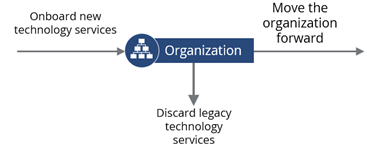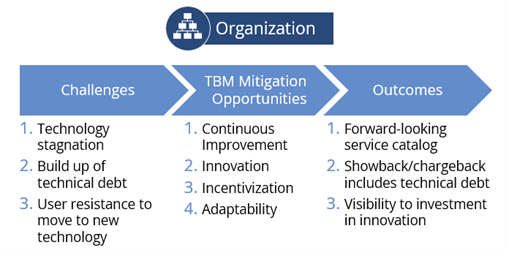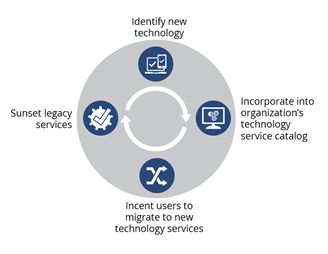The Benefits of Technology Adoption
Modernizing technology is a common and ongoing challenge for many organizations. It is difficult to incorporate innovative new tools into the daily run, grow and transform activities of an enterprise IT environment. A promising solution to this challenge can be found in a rigorous Technology Business Management (TBM) program that effectively pushes an organization’s technology services forward.
Disciplined IT cost management and cost allocation are integral to a strong TBM practice, yet it is also essential to proactively manage the value of existing IT services and, at the same time, enable the business to modernize its technology. One way to accomplish this is by incentivizing your technology consumers – or employees – to adopt services that are also best for the business. This will move an organization’s TBM practice beyond IT cost management and into IT value management.
Enterprise users consume a defined set of IT services that are to be expensed and recovered. Over time, this set of services changes based on the organization’s technology roadmap, which is influenced and adjusted by executive leadership, market and industry movement, external providers and consultants, and often just pure innovation over time. We often encounter client service catalogs that contain a significant number of legacy services that contribute to a buildup of technical debt and stagnant innovation. The challenge here is to incent the technology consumers in the enterprise to adjust and shift with the roadmap. A TBM practice that implements transparency, in both financial and operational terms, can encourage employees to migrate toward modernized services and systems as the technology roadmap progresses.
One goal of a TBM practice should be to enable and support the fluid onboarding and sunsetting of IT services in its service catalog. When this happens and employees are incentivized to use them, we see an increase in organizational adaptability.
The Benefits of Incentivization
 An effective incentivization system offers several benefits. First, an incentivization program helps an organization and its technology consumers stay up to date with the rapid pace of technology modernization. Improved technology adoption creates greater organizational agility and gives an organization a clear competitive advantage.
An effective incentivization system offers several benefits. First, an incentivization program helps an organization and its technology consumers stay up to date with the rapid pace of technology modernization. Improved technology adoption creates greater organizational agility and gives an organization a clear competitive advantage.
Preventing and minimizing technical debt are other positive outcomes of incentivization. Technical debt can be difficult for enterprises to overcome because users are often resistant to change, and pivoting toward modernized technology can become more difficult the longer an organization waits. Incentivization through TBM allows for easier identification of legacy technology and its financial risk. An enterprise that does not incent its employees to use newer technology lacks visibility into usage metrics and change momentum. But if it brings in new services, governs them through a TBM practice and incents employees to adopt them, it can more easily analyze the forces that influence or counter-influence change.

The Mechanics of Incentivization
With a typical TBM framework, the business will assign rates based on complexity of services and charge a bill based on consumption details. The portrayal of these costs is called “showback,” and the recovery of these costs is called “chargeback.” Most organizations are purely focused on showing and charging back costs that are realized. In other words, the framework doesn’t account for unseen costs. Oftentimes, unseen costs attributed to services in a service catalog are related to technical debt.
 Technical debt, from a service perspective, is the inflated cost of running a service that is considered obsolete or legacy; it assumes technology that enables legacy services will cost more to run. Over time, it can become more costly and difficult to move consumers from legacy services to more modern ones. Building, reviewing and updating the rates in your TBM service catalog to reflect technical debt can help incent movement away from legacy services.
Technical debt, from a service perspective, is the inflated cost of running a service that is considered obsolete or legacy; it assumes technology that enables legacy services will cost more to run. Over time, it can become more costly and difficult to move consumers from legacy services to more modern ones. Building, reviewing and updating the rates in your TBM service catalog to reflect technical debt can help incent movement away from legacy services.
Then, by using data about who is consuming what service and technology, which is a fundamental to accurate showback and chargeback as part of a TBM program, IT leaders can balance the consumption and service value with technical debt and show the cost of legacy technology to consumers. It’s been shown that this kind of rate incentivization ultimately leads to consistent progress in technology adoption.
Multiplying price and quantity (P*Q) is a standard method for charging and recovering service costs. With this idea, a price or rate is set for each service and the quantity of the consumed service. As technology and platforms advance and services change, organizations can use their TBM program to incent behavior by charging an inflated rate for older services. For instance, an organization could charge a higher rate for a legacy service to make it more attractive to use the new one. The goal is to shift consumers away from older technology because of the higher overall cost and complications involved in supporting legacy technology.
Moving an Organization to New Technology
A TBM program also can create and offer rebates to be paid out post-onboarding to the successor service. Either way, the objective is to have a financial mechanism that 1) accounts for the aging of a legacy service when there is a successor in place, and 2) incents the service consumers to stay on the latest and greatest service. These two aspects can help build a more accurate total cost of ownership (TCO) of a service and identify stragglers in the organization that need to move to newer platforms.
Let’s say an organization offers virtual machines, and it becomes clear that applications built on virtual machines can be rearchitected to run on containers. To keep the organization moving to the newer architecture, it will want to incent those business application owners to migrate from virtual machines to containers by raising the rate for consuming virtual machines and lowering the rate for running on containers. The organization also reaps the inherent benefits of the newer technology (i.e., better resiliency and easier application porting). Naturally, as more consumers of the older service migrate onto the newer service, the higher the cost for the legacy service consumers.
The TBM Framework at Work
The TBM framework calls for managing IT like a business. As more organizations seek ways to bring value to customers, incentivization is a promising approach to continuously improve technology value and move a business forward. Using an incentivization system built on IT Financial Management and TBM practices can influence consumption behavior and create a more accurate TCO.
ISG encourages organizations to leverage the power of a sound TBM practice to help understand the true cost and value of IT. This practice should include a catalog of IT services that are not fixed in nature and are designed to enable and boost an organization’s capability to propel forward and take advantage of the latest and greatest technology.
